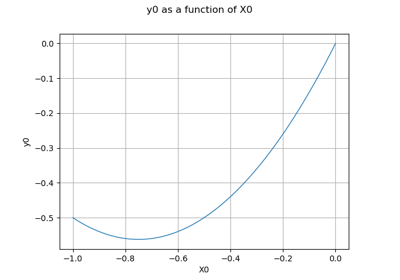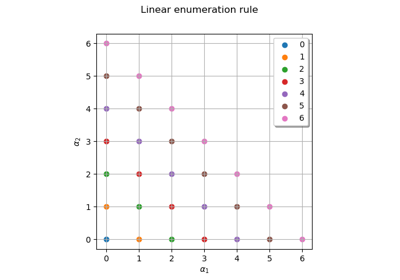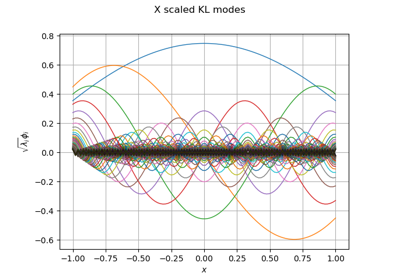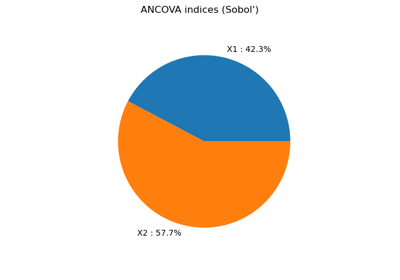LinearEnumerateFunction¶
- class LinearEnumerateFunction(*args)¶
Linear enumerate function.
- Available constructors:
LinearEnumerateFunction(dim=1)
- Parameters:
- dimint
Dimension.
Notes
Given an input random vector
with prescribed probability density function (PDF)
, it is possible to build up a polynomial chaos (PC) basis
. Of interest is the definition of enumeration strategies for exploring this basis, i.e. of suitable enumeration functions
from
to
, which creates a one-to-one mapping between an integer
and a multi-index
.
Let us first define the total degree of any multi-index
in
by
. A natural choice to sort the PC basis (i.e. the multi-indices
) is the lexicographical order with a constraint of increasing total degree. Mathematically speaking, a bijective enumeration function
is defined by:
such that:
and
Such an enumeration strategy is illustrated in a two-dimensional case (i.e.
) in the figure below:
(
Source code,png)
This corresponds to the following enumeration of the multi-indices:
j
0
{0, 0}
1
{1, 0}
2
{0, 1}
3
{2, 0}
4
{1, 1}
5
{0, 2}
6
{3, 0}
7
{2, 1}
8
{1, 2}
9
{0, 3}
Examples
>>> import openturns as ot >>> # 4-dimensional case >>> enumerateFunction = ot.LinearEnumerateFunction(4) >>> for i in range(9): ... print(enumerateFunction(i)) [0,0,0,0] [1,0,0,0] [0,1,0,0] [0,0,1,0] [0,0,0,1] [2,0,0,0] [1,1,0,0] [1,0,1,0] [1,0,0,1]
Methods
__call__(index)Call self as a function.
getBasisSizeFromTotalDegree(maximumDegree)Get the basis size corresponding to a total degree.
Accessor to the object's name.
Return the dimension of the EnumerateFunction.
getId()Accessor to the object's id.
getMaximumDegreeCardinal(maximumDegree)Get the number of multi-indices of total degree lower or equal to a threshold.
getMaximumDegreeStrataIndex(maximumDegree)Get the largest index of the strata containing multi-indices lower or equal to the given maximum degree.
getName()Accessor to the object's name.
Accessor to the object's shadowed id.
getStrataCardinal(strataIndex)Get the number of multi-indices in the basis inside a given strata.
getStrataCumulatedCardinal(strataIndex)Get the number of multi-indices in the basis inside a range of stratas.
Accessor to the upper bound.
Accessor to the object's visibility state.
hasName()Test if the object is named.
Test if the object has a distinguishable name.
inverse(indices)Get the antecedent of a indices list in the EnumerateFunction.
setDimension(dimension)Set the dimension of the EnumerateFunction.
setName(name)Accessor to the object's name.
setShadowedId(id)Accessor to the object's shadowed id.
setUpperBound(upperBound)Accessor to the upper bound.
setVisibility(visible)Accessor to the object's visibility state.
- __init__(*args)¶
- getBasisSizeFromTotalDegree(maximumDegree)¶
Get the basis size corresponding to a total degree.
- Parameters:
- max_degint
Maximum total degree.
- Returns:
- sizeint
Number of multi-indices in the basis of total degree
.
Notes
In the specific context of a linear enumeration (
LinearEnumerateFunction) this is also the cumulated cardinal of stratas up to max_deg.Examples
>>> import openturns as ot >>> dim = 2 >>> enum_func = ot.LinearEnumerateFunction(dim) >>> enum_func.getBasisSizeFromTotalDegree(3) 10 >>> enum_func.getStrataCumulatedCardinal(3) 10
- getClassName()¶
Accessor to the object’s name.
- Returns:
- class_namestr
The object class name (object.__class__.__name__).
- getDimension()¶
Return the dimension of the EnumerateFunction.
- Returns:
- dimint,
Dimension of the EnumerateFunction.
- dimint,
- getId()¶
Accessor to the object’s id.
- Returns:
- idint
Internal unique identifier.
- getMaximumDegreeCardinal(maximumDegree)¶
Get the number of multi-indices of total degree lower or equal to a threshold.
- Parameters:
- max_degint
Maximum total degree.
- Returns:
- cardinalint
Number of multi-indices in the basis of total degree
.
Notes
In the specific context of a linear enumeration (
LinearEnumerateFunction) this is also the cumulated cardinal of stratas of index.
Examples
>>> import openturns as ot >>> dim = 2 >>> enum_func = ot.LinearEnumerateFunction(dim) >>> enum_func.getMaximumDegreeCardinal(2) 6
- getMaximumDegreeStrataIndex(maximumDegree)¶
Get the largest index of the strata containing multi-indices lower or equal to the given maximum degree.
- Parameters:
- max_degint
Maximum total degree.
- Returns:
- indexint
Index of the last strata that contains multi-indices of total degree
.
Notes
In the specific context of a linear enumeration (
LinearEnumerateFunction) this is the strata of index max_deg.Examples
>>> import openturns as ot >>> dim = 2 >>> enum_func = ot.LinearEnumerateFunction(dim) >>> enum_func.getMaximumDegreeStrataIndex(2) 2
- getName()¶
Accessor to the object’s name.
- Returns:
- namestr
The name of the object.
- getShadowedId()¶
Accessor to the object’s shadowed id.
- Returns:
- idint
Internal unique identifier.
- getStrataCardinal(strataIndex)¶
Get the number of multi-indices in the basis inside a given strata.
- Parameters:
- strataIndexint
Index of the strata of the tensorized basis.
- Returns:
- cardinalint
Number of multi-indices in the basis inside the strata strataIndex.
Notes
In the specific context of a linear enumeration (
LinearEnumerateFunction) the strata strataIndex consists of a hyperplane of all the multi-indices of total degree strataIndex, and its cardinal is strataIndex + 1.Examples
>>> import openturns as ot >>> dim = 2 >>> enum_func = ot.LinearEnumerateFunction(dim) >>> enum_func.getStrataCardinal(2) 3
- getStrataCumulatedCardinal(strataIndex)¶
Get the number of multi-indices in the basis inside a range of stratas.
- Parameters:
- strataIndexint
Index of the strata of the tensorized basis.
- Returns:
- cardinalint
Number of multi-indices in the basis inside the stratas of index lower or equal to strataIndex.
Notes
The number of multi-indices is the total of multi-indices inside the stratas. In the specific context of a linear enumeration (
LinearEnumerateFunction) this returns the number of multi-indices of maximal total degree strataIndex.Examples
>>> import openturns as ot >>> dim = 2 >>> enum_func = ot.LinearEnumerateFunction(dim) >>> enum_func.getStrataCumulatedCardinal(2) 6 >>> sum([enum_func.getStrataCardinal(i) for i in range(3)]) 6
- getUpperBound()¶
Accessor to the upper bound.
- Returns:
- ubsequence of int
Upper bound of the indices (inclusive).
- getVisibility()¶
Accessor to the object’s visibility state.
- Returns:
- visiblebool
Visibility flag.
- hasName()¶
Test if the object is named.
- Returns:
- hasNamebool
True if the name is not empty.
- hasVisibleName()¶
Test if the object has a distinguishable name.
- Returns:
- hasVisibleNamebool
True if the name is not empty and not the default one.
- inverse(indices)¶
Get the antecedent of a indices list in the EnumerateFunction.
- Parameters:
- multiIndexsequence of int
List of indices.
- Returns:
- antecedentint
Represents the antecedent of the multiIndex in the EnumerateFunction.
Examples
>>> import openturns as ot >>> dim = 2 >>> enum_func = ot.LinearEnumerateFunction(dim) >>> for i in range(6): ... print(str(i)+' '+str(enum_func(i))) 0 [0,0] 1 [1,0] 2 [0,1] 3 [2,0] 4 [1,1] 5 [0,2] >>> print(enum_func.inverse([1,1])) 4
- setDimension(dimension)¶
Set the dimension of the EnumerateFunction.
- Parameters:
- dimint,
Dimension of the EnumerateFunction.
- dimint,
- setName(name)¶
Accessor to the object’s name.
- Parameters:
- namestr
The name of the object.
- setShadowedId(id)¶
Accessor to the object’s shadowed id.
- Parameters:
- idint
Internal unique identifier.
- setUpperBound(upperBound)¶
Accessor to the upper bound.
- Parameters:
- ubsequence of int
Upper bound of the indices (inclusive).
- setVisibility(visible)¶
Accessor to the object’s visibility state.
- Parameters:
- visiblebool
Visibility flag.
Examples using the class¶

Create a multivariate basis of functions from scalar multivariable functions
 OpenTURNS
OpenTURNS








